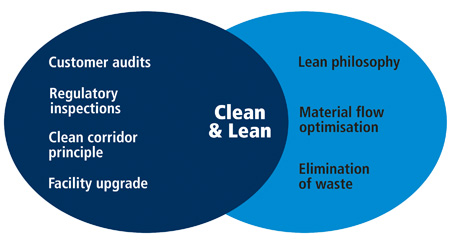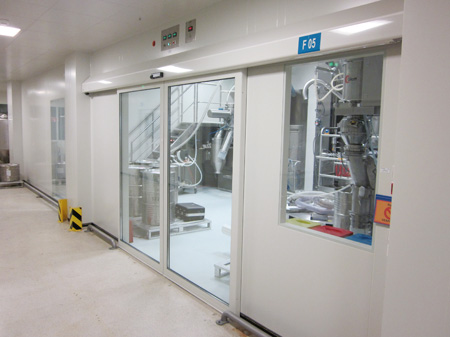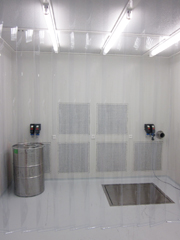To meet the moving target of best practice, production facilities regularly need updating or redesigning. MD Eric Schmidhäuser, explains how CMO Catalent reconfigured its Schorndorf site in Germany while maintaining customer orders and expectations.
Opened in 1996, Catalent’s 221,000ft2 Schorndorf site comprises two facilities for the manufacture and packaging of controlled release and oral dose forms, and for clinical trial supply services. The controlled release manufacturing facility had grown organically over a decade of operations to meet changing regulatory, customer and market demands. While significant efforts had been made to keep the facility, equipment, materials and workflow logical, the continued advance of manufacturing and regulatory best practice eventually necessitated a significant re-assessment of the site layout and operations.
Following lengthy evaluations, the management team decided that a fundamental redesign and improvement in the facility’s layout was required. Due to increased customer demand, Catalent wanted to transform Schorndorf into a European base for the development and supply of complex oral solids.
This would involve:
- The addition of R&D and commercial-scale fluid bed technology, OptiMelt hot-melt extrusion, and elevated cGMP compliance for handling of OEB class 3 customer products
- The air handling, originally designed to create over-pressure manufacturing suites, changed to new best practice of coupling over-pressure corridors with under-pressure manufacturing suites
- Improvement to materials flow to reduce cycle times and waste
However, with the facility operating at very high capacity utilisation, it was determined that the construction work would affect around 50% of the production area and 60% of products manufactured on the site. Consequently, the project plans needed to ensure there was minimum disruption of supply to the site’s customer base.
The specific requirements of the project were to:
- Adopt a clean corridor approach to manufacturing, completely reversing the relationship of positive pressure manufacturing suites to under-pressure manufacturing suites and higher pressure corridors that would help reduce particulate entry at an earlier stage. This would enable future cGMP compliance and reduce the potential for cross-contamination
- Upgrade manufacturing capacity with the installation of new equipment, including three large fluid-bed granulators up to 5.5 tonnes
- Improve facility design to facilitate better materials flows and waste management, and to fully adopt Lean Manufacturing principles
- Throughout project execution, minimise and mitigate customer impact to complete the project with a zero backlog
Because the development was already extensive, there was also the opportunity to update other key site services, including renewing weighing control systems and software, and upgrading the purified water systems.
Lean principles
As the central tenets of the project encompassed compliance with cGMP and enhanced manufacturing processes through Lean principles, during planning it became clear that the most direct approach to making the improvements could significantly compromise production capacity and may lead to backlogs, threatening security of supply. The project team recognised that creativity, flexibility and excellence in execution would all be needed to minimise the impact on customers and that schedule changes could only happen in unison with customers’ plans.
Through modelling numerous scenarios at planning reviews, certain key initiatives were incorporated to ensure reliable supply.
First, customers would be engaged and become part of the planning process. Through the sharing of Catalent’s intentions and each customer’s engagement, plans were created to meet the needs of ongoing production and the improvement programme.
For example, the project would be split into three discrete phases, with breaks in the redevelopment set aside in advance. Although this would inevitably extend the duration of the project, the breaks would allow the project team to handle any unforeseen issues and would allow operations to keep pace with the ongoing production schedule.
Holiday periods became key events in the programme when the most disruptive elements of the construction could take place. In addition, engagement of the entire workforce allowed planning for additional shifts to compensate for temporary reductions in capacity.

Figure 1: The main Lean principles
Phased transfer
With prior customer approval (and qualification/validation within the DMF framework) new fluid-bed granulators were used to mitigate the loss of output from existing machines during their movement. Transfer of the key bottleneck equipment was phased to mitigate risk. Communications were planned in advance and were aligned within the Catalent, customer’s and supplier’s team structures. The key objectives of compliance, capacity and efficiency were critical to sustain and build business performance.
Catalent’s customers demand that the highest levels of regulatory compliance are achieved and the project demonstrated the organisation’s commitment to invest proactively and improve its facilities. The Schorndorf site has an excellent compliance record and, says Catalent, the improvements have given its customers the confidence not only to keep existing product on the site, but also to expand the product base.

Entry to the fluid bed area from the corridor
The additional capacity has broadened the scope and scale of operations in Schorndorf, offering European customers access to state-of-the-art capability for development and commercial scale fluid bed granulation. Since completion of the project, all facilities are fully commissioned and existing customer projects back underway. In addition to new product introductions also taking place at the facility the programme has allowed for the development of a broader ‘opportunity funnel’ for the site too.
Greater utilisation
Overall, the company believes its customers have benefited from the assurance of future cGMP compliance, being able to access more comprehensive development and manufacturing capabilities and capacity, and from the knowledge that these services are offered efficiently and with reduced environmental impact. Specifically, one customer has been able to increase product uptake by 66% since completion of the Clean & Lean project.
The improvements have greatly enhanced manufacturing efficiencies, reducing cycle times and minimising waste. This has allowed for more sustainable manufacturing processes and has also reduced the costs associated with manufacture.

The weighing area before the refurbishment
When considering the scope, complexity, and continuous high utilisation to meet production targets on site, the planning and execution of the Clean & Lean project was an outstanding success and key project parameters were all exceeded:
- The project was completed one month ahead of schedule
- The project was completed under budget (saving $200,000)
- No customer backlog occurred during the project or at completion
Over and above these key deliverables, there are further points of distinction.
The FDA audit conducted during project execution (while there was significant disruption to production areas and operations) was successfully concluded with no (Form 483) observations. In addition, more than 50,000 hours of project work was completed with no increase in levels of reportable accidents or lost hours. The company maintained excellent relations with its highly engaged and motivated workforce.

The refurbished weighing area after the upgrade
The key factors that helped the project run smoothly were:
- Engaging customers in the project planning process, so that their needs were fully understood and incorporated into the plan from the very start
- Effective communication continued between project teams and at various levels of management within customer and supplier organisations
- High levels of engagement from the entire site, customers and suppliers was essential in ensuring that three key stages of the plan were completed safely
- Effective planning and a specific regard to contingency and risk mitigation were all key to maintaining reliable supply
This involved discipline in project management and execution, dedicated resources, frequent meetings, engagement and involvement from senior leadership, including daily site walks.
There are two key characteristics of Catalent that have enabled success in this project: customer focus and engagement of the entire team.
Catalent management, site leadership team and quality groups listened to customers who visited and audited the site and recognised that enhancement would make compliance and later expansion easier.

Installation of the fluid bed equipment
That allowed the team to pre-empt customer requirements for additional capabilities, offered with the most efficient and sustainable manufacturing methods. Through this high level of customer focus the team engaged in a far more complex and multi-faceted project, not only requiring significant investment but also delivering more quickly the assurances, capabilities and efficiencies valued by customers.
The success of the Clean & Lean project results from a common goal by the entire site to deliver a successful project. For example, it was initially agreed with the Workers Council to extend workers’ 5- to 6-day weeks to 7-day weeks over no more than 15 weekends. When it became apparent that this was insufficient to meet deadlines, individual workers volunteered to work extra days over more weekends to ensure that there were no delays to the schedule.
That a project of this complexity was delivered ahead of budget, ahead of time, without affecting customers’ product delivery schedules, and that FDA auditors made no observations despite inspecting in the midst of construction, is testament to all those involved.
Catalent Pharma Solutions’ Lean Programme – Excellence in Customer Focus and Project Management won the award for Most Improved Facility at the Pharma Outsourcing Awards in October 2012.




